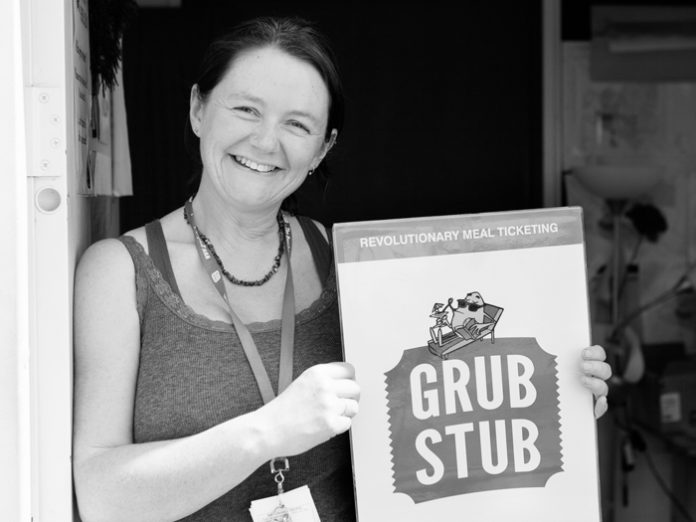Lou Fitzpatrick has extensive experience in festival and event management. With a passion for technology and problem solving, Lou is always looking for ways to streamline processes to make lives easier for event managers, the production office and on-site operations. Having experienced firsthand the demands of managing meal tickets from 20 years at the heart of event production, Lou knew there had to be a better way to manage the process and so created Grub Stub; an online meal management system that turns a spreadsheet of requirements into one manageable meal ticket per person. Not only has the system proved to save a huge amount of time, it has also highlighted the staggering costs associated with uneaten meals.
The environmental impact of festivals is a hot topic, particularly when it comes to the use of plastic, energy and transport. An increasingly prominent issue is the impact of food waste from a festival’s crew and artists.
Grub Stub has revealed that an average of 40% of crew meals go uneaten. This is a staggering number of meals wasted, creating an unnecessary strain on resources, caterers, budget and the environment.
Assuming a meal costs as little as £5, Grub Stub revealed that on average festivals are spending £23,500 on uneaten crew meals, which rises to £100,000 for events with more than 35,000 allocated meals. Since its launch, our online meal management system has identified a staggering £748,500 that has been spent on wasted meals.
This is not only a concern for budget holders but it has a serious environmental impact too.
Consider the production and travel of the food – huge amounts of resources are used as food is grown, harvested and kept, often transported around the world. It takes an astonishing 1,927 kilolitres (one thousand litres) of water to produce a tonne of food representative of what would be provided as crew meals. In addition, the average food item has travelled 4,133 miles to get to the plate, and will often travel even further to end up in landfill.
Food waste is especially harmful when not disposed of properly. When food is sent to landfill it not only produces six tonnes of CO2 for every one tonne deposited but it also produces methane, which is up to 23 times more potent as a greenhouse gas.
The average event will have to dispose of 1.6 tonnes of uneaten food, with some large events dealing with up to eight tonnes of food waste. This amounts to the creation of between six and 35 tonnes of CO2 per event, but what might seem like a scary set of figures actually represents a huge opportunity to make a positive impact on how crew and artists’ meals are managed at festivals around the world.
Data and analytics are key for improving processes when running events. You can achieve extremely valuable and rewarding insights for your events using Grub Stub, meaning food waste is an issue that can be tackled head on.
The costs of uneaten meals are often swept under the carpet or incorrectly calculated, but if data can be analysed then we can achieve a better understanding of the underlying reasons why meals are not being eaten and how to best respond to informed predictions.
Are crew too busy or do mealtimes need to be changed? Have dietary requirements been taken into consideration and communicated accurately? Are meat eaters selecting meals allocated for vegetarians? Do less people eat breakfast or are other options on-site resulting in crew getting their food elsewhere? There are lots of factors that can impact the redemption rate of allocated meals, and what may seem like a straightforward task on the surface is actually one full of complexity.
With the data of over 50 events, Grub Stub is in a unique position to help understand the reasons for uneaten meals and produces never before achieved insights for redemption patterns, forecasting and industry trends. This allows event organisers and caterers to identify opportunities to save time, money and food, and also increase accountability for over-ordering. Working closely with event organisers, Grub Stub can provide valuable advice in a Catering Guide to produce realistic redemption rates.
For example, when organisers utilise Grub Stub’s Catering Guide the average redemption rate increases to 90%, significantly higher than the initial average of 60%. There is a real opportunity to make improvements and savings, so much so that you can feel the benefits within a short time frame. Events that utilised the Catering Guide wasted 16% less meals in year one alone.
Savings that can be made may be specific to the event itself or down to trends we see consistently across the board, such as typical redemption rates for certain days. Typically, Grub Stub data shows that the first day post-show has shockingly low breakfast redemption rates as opposed to Friday dinner time where the redemption rate is high. Trends across completely unrelated events are surprisingly similar in redemption pattern comparison.
When it comes to feeding people there are a lot of opportunities to save time, money and food, and the savings are typically much greater than the cost of engaging Grub Stub. Catering is a complex line in the budget but that should not be a reason to bury your head in the sand. By being proactive and developing a deeper understanding of your crew you can really feel the benefits, ones that will complement other environmental policies being widely pursued.





